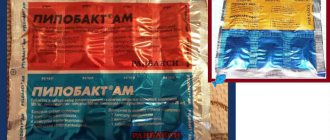Release form and composition
The drug is produced in the form of dispersible tablets: oval, biconvex, white to light yellow in color, have a light fruity taste; tablets with a dosage of 250 mg - with a score on one side (in blister packs of 10 pcs., in a cardboard pack of 2 packs; in polypropylene bottles of 10 pcs. with a dosage of 1000 mg and 20 pcs. with a dosage of 125, 250 and 500 mg, in cardboard pack 1 bottle.Each pack also contains instructions for using Amoxicillin EXPRESS).
1 tablet contains:
- active ingredient: amoxicillin - 125, 250, 500 or 1000 mg (in the form of amoxicillin trihydrate - 143.47; 286.95; 573.89 and 1147.78 mg, respectively);
- auxiliary components: saccharin, vanillin, crospovidone, magnesium stearate, microcrystalline cellulose, lemon flavor, tangerine flavor.
Composition of Amoxicillin tablets
The antibiotic is produced in dosages from 125 mg to 1 gram. The active component of the drug is the substance of the same name – amoxicillin in the form of trihydrate. The following are used as auxiliary components:
- magnesium stearate;
- talc;
- potato starch.
The capsules also contain enteric coating components.
The medicine belongs to the semi-synthetic antibiotics of the penicillin series. It is effective against gram-negative and gram-positive bacteria, as well as gram-negative rods. The active component helps to inhibit cell wall synthesis, thereby stopping the increase in colonies of pathogenic microorganisms.
Pharmacological properties
Pharmacodynamics
Amoxicillin EXPRESS is a broad-spectrum antibacterial drug. Its active substance, amoxicillin, belongs to the group of semisynthetic penicillins, is a 4-hydroxyl analogue of ampicillin, and has a bactericidal effect.
The following microorganisms are sensitive to amoxicillin:
- aerobic gram-positive bacteria: Staphylococcus speciales (spp.) (except penicillinase-producing strains), Streptococcus spp.;
- aerobic gram-negative bacteria: Neisseria meningitidis, Neisseria gonorrhoeae, Escherichia coli, Salmonella spp., Shigella spp., Klebsiella spp.
Against Helicobacter pylori, it exhibits an antibacterial effect in combination with metronidazole. Amoxicillin is believed to inhibit the development of Helicobacter pylori resistance to metronidazole.
The spectrum of activity of Amoxicillin EXPRESS expands when used simultaneously with clavulanic acid (a beta-lactamase inhibitor). This combination increases the effectiveness of amoxicillin against bacteria such as Legionella spp., Bacteroides spp., Nocardia spp. and Pseudomonas (Burkholderia) pseudomallei. But a large number of other gram-negative bacteria, including Pseudomonas aeruginosa and Serratia marcescens, remain resistant to it.
Amoxicillin EXPRESS does not show activity against microorganisms that produce penicillinase.
Cross-resistance occurs when used simultaneously with ampicillin.
Pharmacokinetics
After oral administration, amoxicillin is not destroyed in the acidic environment of the stomach, but is quickly and completely absorbed from the gastrointestinal tract (GIT). The total absorption in the presence of food in the stomach is not reduced. The maximum concentration (Cmax) of amoxicillin in the blood plasma is reached after 1–2 hours. If the dose is increased by 2 times, then the concentration level also increases by 2 times. With parenteral (intravenous and intramuscular administration) and oral administration of amoxicillin, similar concentrations in the blood are achieved.
Plasma protein binding is approximately 20%.
Widely distributed in tissues and body fluids, found in high concentrations in the liver.
When there is inflammation of the pia mater, amoxicillin penetrates the blood-brain barrier in small quantities. Crosses the placental barrier and is excreted in breast milk.
The half-life (T1/2) from plasma is 1–1.5 hours.
About 60% of the dose taken is excreted unchanged through the kidneys through glomerular filtration and tubular secretion. The concentration of amoxicillin in the urine while taking the drug at a dose of 250 mg is more than 0.3 mg/ml. Some amoxicillin is excreted through the intestines.
It should be taken into account that in elderly patients and newborns T1/2 may increase. In case of renal failure, T1/2 can range from 7 to 20 hours.
Hemodialysis removes amoxicillin from the body.
Description of the drug
Amoxicillin was developed in the early 70s. This is an antibacterial drug from the penicillin class, belonging to semi-synthetic antibiotics. Amoxicillin is closest to ampicillin, but differs from it in the presence of a hydroxyl group. This makes the drug more biologically available when taken orally (not intravenously). Amoxicillin is also more resistant to the action of gastric juice compared to ampicillin, which determines its better absorption from the gastrointestinal tract and high bioavailability.
After administration, this type of penicillin penetrates into all tissues and fluids of the body, which determines its high therapeutic effect. There is also a direct relationship between the dose and the concentration of the substance in the body, that is, doubling the dose entails doubling the concentration of the substance. 50-70% of amoxicillin is excreted by the kidneys; only a small part of the drug is excreted through the liver.
The drug belongs to the antibacterial bactericidal agents. The principle of action of amoxicillin is based on its effect on certain enzymes that make up the cell walls of bacteria. Without these enzymes, cell walls are destroyed and bacteria die.
Amoxicillin is active against various types of microorganisms, both gram-positive and gram-negative. However, its effect is far from universal, since there are microorganisms that are resistant to the action of amoxicillin. In particular, these are bacteria capable of producing beta-lactamase, which neutralizes the antibiotic. Therefore, amoxicillin is often produced in combination with clavulanic acid, which protects amoxicillin from the action of beta-lactamase.
However, amoxicillin in its pure form is also used quite often, despite its narrower spectrum of action compared to the combination of amoxicillin and beta-lactamase. This is explained, on the one hand, by the lower price of the pure drug, and on the other hand, by fewer side effects.
Also, a combination of amoxicillin and metronidazole is used to treat infections caused by Helicobacter pylori.
Bacteria affected by amoxicillin:
- salmonella,
- staphylococci,
- streptococci,
- shigella,
- gonococci.
Indications for use
The use of Amoxicillin EXPRESS is indicated as monotherapy and in combination with clavulanic acid in the treatment of infectious and inflammatory diseases caused by sensitive microorganisms, including bronchitis, pneumonia, tonsillitis, pyelonephritis, urethritis, gastrointestinal infections, gynecological infectious pathologies, gonorrhea, listeriosis, leptospirosis, skin infections and soft tissues.
In addition, in combination with metronidazole, the drug is prescribed during the period of exacerbation of chronic gastritis and gastric and duodenal ulcers associated with Helicobacter pylori.
Analogs
There are many analogues of Amoxicillin on sale:
- Amoxiclav;
- Azithromycin;
- Flemoxin Solutab;
- Ampicillin;
- Doxycycline;
- Clarithromycin.
Contraindications
Absolute:
- Infectious mononucleosis;
- lymphocytic leukemia;
- severe gastrointestinal infections accompanied by diarrhea or vomiting;
- respiratory viral infections;
- allergic diathesis;
- bronchial asthma;
- hay fever;
- established individual intolerance to penicillins and/or cephalosporins;
- hypersensitivity to the components of the drug.
Additional contraindications for the use of Amoxicillin EXPRESS tablets as part of combination therapy with metronidazole:
- diseases of the nervous system;
- hematopoietic disorders;
- liver diseases;
- age under 18 years;
- hypersensitivity to nitroimidazole derivatives.
The use of the drug in combination with clavulanic acid is contraindicated in patients with a history of liver dysfunction or jaundice caused by the simultaneous use of amoxicillin and clavulanic acid.
Amoxicillin EXPRESS should be used with caution if you have a history of allergic reactions, a history of gastrointestinal diseases, liver/renal failure, during pregnancy and lactation, in premature infants, and in old age.
What is better for children: Doxycycline or Amoxicillin?
Doxycycline is a tetracycline antibiotic. It is contraindicated in children under 8 years of age, as the drug can form insoluble complexes with calcium, which will be deposited in the child’s teeth and bones. Doxycycline has a broad spectrum of action and strains that are not affected by penicillins may be sensitive to it.
But it also has contraindications and side effects, so the doctor must decide which antibiotic is best on an individual basis.
Amoxicillin EXPRESS, instructions for use: method and dosage
Amoxicillin EXPRESS dispersible tablets are taken orally, after dissolving them in a small amount of water (at least 50 ml), regardless of meals.
The doctor determines the dose and duration of treatment individually, taking into account clinical indications, age and weight of the patient.
The recommended dosage has the following age restrictions:
- adults and children over 10 years of age (body weight more than 40 kg): 250–500 mg 3 times a day at regular intervals. In severe cases of the disease, an increase in the single dose to 1000 mg is indicated;
- children aged 5 to 10 years: 250 mg 3 times a day at regular intervals;
- children aged 2 to 5 years: 125 mg 3 times a day at regular intervals.
Depending on the indications and clinical situation, for children with body weight less than 40 kg, the daily dose can be determined at the rate of 20–100 mg per 1 kg of body weight and taken in 2–3 doses.
For acute uncomplicated gonorrhea, Amoxicillin EXPRESS is prescribed in combination with probenecid at a dose of 3000 mg once.
If renal function is impaired, the frequency of administration of a single dose of the drug must be adjusted in accordance with the following values of creatinine clearance (CC):
- CC 10–40 ml/min: 2 times a day at regular intervals;
- CC less than 10 ml/min: 1 time per day.
Amoxicillin price, where to buy
The price of Amoxicillin in tablets of 500 mg is 30-35 rubles per pack of 10 pcs. The price of Amoxicillin 1000 mg depends on the manufacturer of the drug. The price of Amoxicillin suspension for children is on average 80-90 rubles per 100 ml bottle. You can buy the antibiotic Amoxicillin Clavulanate, which contains clavulanic acid , for a price starting from 250 rubles.
How much tablets cost in Ukraine (in Odessa, Kharkov and other cities) depends on their manufacturer. The cost of the drug is from 45 hryvnia for 10 tablets. Suspension for children can be bought for an average of 130 hryvnia. Amoxicillin ampoules can be purchased for 160 rubles.
- Online pharmacies in RussiaRussia
- Online pharmacies in UkraineUkraine
- Online pharmacies in KazakhstanKazakhstan
ZdravCity
- Amoxicillin Sandoz tablets p.p.o.
1g 12 pcs Sandoz GmbH 166 RUR order - Amoxicillin granules for prig suspension. for internal approx. 250mg/5ml 40gHemofarm A.D. Vršac, Dubovac production site
108 RUR order
- Amoxicillin capsules 250 mg 16 pcs. Hemofarm koncern AD
62 RUR order
- Amoxicillin express dispersible tablets. 125mg 20pcs JSC "LEKKO"
103 rub. order
- Amoxicillin express dispersible tablets. 250mg 20pcs JSC "LEKKO"
177 RUR order
Pharmacy Dialogue
- Amoxicillin Sandoz tablets 1000 mg No. 12Sandoz
164 RUR order
- Amoxicillin capsules 500 mg No. 16Hemofarm
105 rub. order
- Amoxicillin capsules 250 mg No. 16Hemofarm
48 RUR order
- Amoxicillin tablets 500 mg No. 20 Barnaul ZMP
63 RUR order
- Amoxicillin granules for suspension 250mg/5ml 100mlHemofarm
96 RUR order
show more
PaniPharmacy
- Amoxicillin 15% 100ml Ukraine, Olkar
252 UAH. order
show more
Side effects
The frequency of adverse events of Amoxicillin EXPRESS is determined as follows: very often (≥ 1/10); often (from ≥ 1/100 to < 1/10); uncommon (from ≥ 1/1000 to < 1/100); rare (from ≥ 1/10,000 to < 1/1000); extremely rare (< 1/10,000); with an unknown frequency (based on the available data, the frequency of adverse reactions cannot be estimated).
- immune system: extremely rarely - severe allergic reactions such as anaphylaxis, angioedema, allergic vasculitis and serum sickness; with unknown frequency - Kounis syndrome (acute coronary syndrome associated with hypersensitivity), Jarisch-Herxheimer reaction;
- blood and lymphatic system: extremely rarely - reversible thrombocytopenia, reversible leukopenia (including agranulocytosis and severe neutropenia), hemolytic anemia, prolongation of prothrombin time and bleeding time;
- nervous system: extremely rarely - dizziness, hyperkinesia, convulsions; with unknown frequency - aseptic meningitis;
- digestive system (based on clinical studies): often - nausea, diarrhea; rarely - vomiting; extremely rarely (based on data obtained in the post-registration period) - superficial discoloration of tooth enamel, black “hairy” tongue, colitis associated with taking antibiotics (including hemorrhagic and pseudomembranous);
- skin and subcutaneous tissues (based on clinical studies): often - skin rash; rarely – itching, urticaria; extremely rare (based on data obtained in the post-registration period) - exfoliative and bullous dermatitis, Stevens-Johnson syndrome, erythema multiforme, acute generalized exanthematous pustulosis, toxic epidermal necrolysis (Lyell's syndrome), DRESS syndrome (drug rash with eosinophilia and systemic symptoms );
- liver and biliary tract: extremely rarely - cholestatic jaundice, hepatitis, moderate increase in the activity of AST (aspartate aminotransferase) and/or ALT (alanine aminotransferase) in the blood plasma;
- kidneys and urinary tract: extremely rarely - crystalluria, interstitial nephritis;
- infectious and parasitic pathologies: extremely rarely - candidiasis of the mucous membranes and skin, superinfections (more often with reduced body resistance or the presence of chronic diseases);
- allergic reactions: Quincke's edema, conjunctivitis, rhinitis; rarely – fever, eosinophilia, joint pain; isolated cases - anaphylactic shock;
- others: with long-term use of high doses - confusion, dizziness, depression, ataxia, convulsions, peripheral neuropathies; mainly when combined with metronidazole - stomatitis, glossitis, epigastric pain, nausea, vomiting, diarrhea, constipation, anorexia, in rare cases - allergic reactions (urticaria, angioedema), hepatitis, interstitial nephritis, pseudomembranous colitis, hematopoietic disorders; mainly when combined with clavulanic acid - hepatitis, cholestatic jaundice, in rare cases - toxic epidermal necrolysis, erythema multiforme, exfoliative dermatitis.
Important points
Amoxicillin is intended for the treatment of adult patients and children older than 1 month. Only a doctor can correctly prescribe the drug and calculate the required dosage. In this case, the specialist individually takes into account the age and body weight of the child, the type and severity of the disease, as well as the sensitivity of the infectious agents to this type of antibiotic.
In most cases, a certain dosage of the drug is prescribed twice a day after meals, at regular intervals. This is necessary to maintain the optimal amount of antibiotic in the tissues of the patient’s body.
Amoxicillin should be taken for at least five days. The doctor selects the exact duration of the course of treatment individually.
In rare cases, side effects of the drug may occur, such as:
- allergic reaction (urticaria, allergic rhinitis, etc.);
- dysfunction of the digestive system (diarrhea, nausea, constipation, pain in the stomach);
- dizziness, headache.
If such symptoms occur, you should immediately stop taking the medication and seek medical help.
Overdose
Symptoms: nausea, vomiting and/or diarrhea, contributing to water and electrolyte imbalance, amoxicillin-associated crystalluria, renal failure, and in patients with impaired renal function - convulsions.
Treatment: immediate gastric lavage or artificial vomiting, taking activated charcoal and osmotic laxatives (sodium sulfate). If necessary, hemodialysis and measures to restore water and electrolyte balance are indicated.
special instructions
Before starting therapy with Amoxicillin EXPRESS, it is necessary to pay attention to the presence of hypersensitivity reactions to cephalosporins, penicillins and other beta-lactam antibiotics in the anamnesis.
Some patients treated with penicillin have experienced severe and sometimes fatal hypersensitivity reactions (including severe skin reactions and anaphylactic reactions). Reactions of this type occurred more often in patients with atopy and those with a history of hypersensitivity to penicillins. If an allergic reaction occurs, amoxicillin therapy should be interrupted immediately and appropriate alternative treatment should be prescribed.
There are rare reports of the development of hypersensitivity-related acute coronary syndrome, or Kounis syndrome, during amoxicillin therapy. The occurrence of this reaction is a reason to discontinue the drug and prescribe an appropriate alternative treatment.
For some infections, it is necessary to first establish the type of pathogen and its sensitivity to the drug, or to make sure that the pathogen is likely to be treatable with Amoxicillin EXPRESS. This is particularly relevant for patients with severe ear, nose and throat infections and urinary tract infections.
In patients with impaired renal function, in patients receiving high doses of Amoxicillin EXPRESS or having predisposing factors (history of seizures, treatment of meningitis or epilepsy, etc.), seizures may occur during therapy.
In patients with renal impairment, the dose of amoxicillin should be adjusted according to the degree of renal impairment.
The appearance at the initial stage of treatment of generalized erythema with fever, accompanied by pustules, can serve as a symptom of AGEP (acute generalized exanthematous pustulosis). In this case, amoxicillin therapy is immediately stopped, and its further use is contraindicated in any situation.
Amoxicillin EXPRESS should not be prescribed to patients with suspected infectious mononucleosis, as this may lead to the appearance of a measles-like rash (exanthema), which is a consequence of the use of amoxicillin for this disease.
The Jarisch–Herxheimer reaction has been observed in patients with Lyme disease following the use of amoxicillin. This reaction is associated with the bactericidal effect that Amoxicillin EXPRESS has on the causative agents of Lyme disease - the spirochete Borrelia burgdorferi. Patients should be advised that this reaction is a common side effect of antibiotic treatment for Lyme disease and usually goes away on its own.
With long-term use of Amoxicillin EXPRESS, excessive growth of microorganisms insensitive to amoxicillin (development of superinfection) is possible.
When using almost all antibacterial drugs, the development of colitis associated with taking antibiotics is possible. The severity of the disease can vary from mild to severe (that is, life-threatening). In this regard, it is important to consider the possibility of this diagnosis if patients develop diarrhea during or after the use of antibiotics. If diarrhea occurs, you should stop taking Amoxicillin EXPRESS, seek medical advice and begin appropriate treatment. In this situation, any drugs that inhibit peristalsis are contraindicated.
When carrying out long-term therapy, it is necessary to regularly monitor the function of the hematopoietic organs, liver and kidneys. There are reports of changes in the number of blood cells and increased activity of liver enzymes.
In rare cases, an increase in prothrombin time has been observed in patients receiving amoxicillin. When using Amoxicillin EXPRESS together with anticoagulants, appropriate monitoring is required, and dose adjustment of oral anticoagulants may be required to maintain the required level of blood clotting.
In patients with reduced diuresis, crystalluria was occasionally observed, mainly during parenteral therapy. Patients taking high doses of Amoxicillin EXPRESS should maintain adequate fluid intake and diuresis to reduce the likelihood of developing crystalluria associated with amoxicillin use. In patients with a catheterized bladder, catheter patency should be checked periodically.
Increased levels of amoxicillin in serum and urine may affect some laboratory tests. High concentrations of amoxicillin in urine often cause false-positive results when carrying out chemical analysis methods.
To determine the level of glucose in urine during amoxicillin therapy, it is recommended to use enzymatic glucose oxidase tests.
Taking Amoxicillin EXPRESS may affect the results of the quantitative determination of estradiol in urine in pregnant women.
It is not recommended to drink alcoholic beverages while using Amoxicillin EXPRESS in combination with metronidazole.
Impact on the ability to drive vehicles and complex mechanisms
With long-term use of high doses of Amoxicillin EXPRESS, patients should be careful when performing potentially hazardous activities, including driving, due to the possible occurrence of dizziness, convulsions, and confusion.
Amoxicillin Sandoz 1,000 mg
Film-coated tablets, 12 pcs. 1000 mg each.
Antimicrobial medicine from Europe from the group of penicillin antibiotics. It combines a pronounced cidal effect, a high safety profile and a huge range of applications. It is used in patients over 3 years of age for the treatment of bacterial infections of varying severity and localization.
Active components of tablets:
Amoxicillin trihydrate – 1148 mg (equivalent to 1 g of pure substance);
Additional inactive components:
Tablet core: microcrystalline cellulose, povidone, magnesium stearate, sodium carboxymethylcellulose.
Tablet coating: hypromellose, triclosan dioxide, talc.
Amoxicillin 1000 mg instructions for use
This penicillin antibiotic has a bactericidal effect on a large number of pathogenic bacteria and is used for the following infectious and inflammatory pathologies:
- Respiratory infections (upper and lower)
- As one of the components of Helicobacter pylori eradication therapy;
- Other gastrointestinal infections;
- Infections of the kidneys, bladder and urethra;
- For the prevention of various infections after surgery, incl. after dental operations;
- Borreliosis, leptospirosis, listeriosis;
- Infections of the skin and underlying tissues - muscles, ligaments, tendons.
Amoxicillin, as a penicillin antibiotic, acts on the bacterial enzyme transpeptidase, which is involved in the production of peptidoclycan. This substance is key to the construction of the bacterial cell wall. By inhibiting transpeptidase, amoxicillin deprives the bacterium of the ability to restore its membrane. Microbes also lose their ability to divide because they cannot ensure the integrity of the new bacterial cell. As a result, all pathogenic bacteria are destroyed.
Amoxicillin Sandoz 1000 mg method of use
The tablets are taken whole before, during or after meals.
Standard daily dosage for patients over 12 years of age: 2-3 tablets of 1000 mg.
To prevent postoperative infectious complications: the drug is taken within the first hour after surgery. Adults – 2-3 tablets once, children – 50 mg/kg once. If necessary, as directed by the doctor, treatment can be continued.
Duration of treatment: Until all manifestations of the bacterial infection are eliminated, plus 2-3 days.
NB! Do not reduce the duration of treatment yourself. This can lead to superinfection and a significant deterioration in your health.
Amoxicillin tablets 1000 mg special instructions:
— Use during pregnancy or breastfeeding is not contraindicated. However, before you start taking it, you should consult your doctor for advice.
- In the following cases, treatment should be carried out under the special supervision of a doctor:
- Renal failure (dosage adjustment may be required);
- Infectious mononucleosis or leukemia;
- Epilepsy;
- Catheterization of the urinary organs.
- The use of amoxicillin may lead to changes in blood or urine sugar tests (especially important for patients with diabetes).
Amoxicillin tablets 1g contraindications:
Hypersensitivity and severe allergy to amoxicillin, as well as to other penicillin and cephalosporin antibiotics;
Additionally, for the tablet form - children under 3 years of age (high risk of blocking the respiratory tract with a swallowed tablet).
Amoxicillin 1000 mg interaction with other medications:
When used simultaneously:
- Allopurinol may increase the incidence of allergic skin reactions.
- Methotrexate increases its toxicity.
- The body's absorption of Digoxin increases;
- Warfarin increases the chance of bleeding;
- The effectiveness of oral contraceptives may be reduced.
Amoxicillin Sandoz 1000 mg adverse reactions:
In most cases, the treatment is well tolerated. However, it is potentially possible:
- Disorders of the digestive function of the gastrointestinal tract;
- Nausea and vomiting, change in stool;
- Enanthema;
- Allergic reactions.
Taking the tablets with food may reduce the risk of these unwanted reactions.
Storage conditions:
Keep out of the reach of children at an air temperature of no more than +25ºC.
Use during pregnancy and lactation
In animal studies, no direct or indirect harmful effects of amoxicillin in terms of reproductive toxicity were identified. The limited available data on its use in humans during pregnancy do not confirm the presence of an increased risk of congenital malformations. However, Amoxicillin EXPRESS during pregnancy can only be prescribed by a doctor after a mandatory assessment of the benefits and risks of the therapy.
It is known that amoxicillin is excreted into breast milk in small quantities, therefore, if necessary, its use during breastfeeding is allowed. However, it is worth taking into account that breastfed children whose mothers take Amoxicillin EXPRESS may develop undesirable symptoms such as diarrhea, sensitization and fungal infection of the mucous membranes. If such symptoms are observed, you should immediately stop taking the drug or interrupt breastfeeding.
In connection with the above, the use of Amoxicillin EXPRESS during pregnancy and breastfeeding is allowed only in exceptional cases when the expected therapeutic effect for the mother outweighs the potential risk for the fetus and child.
Reviews
As with any medicine, user reviews vary. For some, the main positive point was the reasonable price and wide spectrum of action. Other parents found it inconvenient to have to give the drug three times a day with a mandatory 8-hour interval between doses. Another disadvantage is the detrimental effect of the antimicrobial agent on the whole range of bacteria in the body. As a result, after completing the course it is often necessary to pay special attention to restoring the intestinal microflora.
- Tamara writes that her granddaughter was prescribed amoxicillin twice: for a long runny nose, and for ear disease. We took the drug in parallel with Linex - and the disease subsided. Toma considers antibiotics an almost win-win treatment option when other means do not help.
- Zoya did not notice any drawbacks in application. Her schoolboy son fell ill with a severe form of sore throat: his lymph nodes were swollen and his throat was very sore. On the advice of the doctor, they immediately began treatment with amoxicillin - and the disease subsided.
- Tatyana and her family also treated sore throat and bronchitis. Tatyana does not consider herself a supporter of antibacterial agents, but sometimes she still has to resort to them. After all, a common cold, if not treated, will remind you of itself for a long time with a debilitating cough or runny nose. In these cases, drugs of the penicillin group do an excellent job of healing. Women especially like the budget price and versatility of action.
- Ira was advised to take the drug by a doctor friend. According to the doctor, amoxicillin is one of the best broad-spectrum bactericidal agents. When the whole family fell ill from a bacterial infection, the effect of the drug became visible almost immediately: within a few hours after the first dose, relief came and the cough became productive.
- Katya also highlights quick tangible results and a minimal number of side effects among the positive properties. A woman treated her third-grader son for the flu, and did not notice any side effects of the medicine. We were treated with capsules, a 7-day course.
Drug interactions
- oral contraceptives: the possible reduction in their effectiveness should be taken into account;
- cephalosporin, cycloserine, aminoglycosides, vancomycin, rifampicin: the listed agents and other bactericidal antibiotics in combination with amoxicillin promote synergism;
- macrolides, chloramphenicol, lincosamides, tetracyclines, sulfonamides: these and other bacteriostatic antibiotics in combination with amoxicillin cause antagonism of action;
- allopurinol: when used simultaneously with amoxicillin, the likelihood of developing allergic skin reactions increases;
- methotrexate: penicillin antibiotics help reduce the excretion of methotrexate, thereby increasing its toxic effect on the body;
- indirect anticoagulants: the effect of indirect anticoagulants and suppression of intestinal microflora are enhanced, the prothrombin index and vitamin K synthesis are reduced;
- NSAIDs (nonsteroidal anti-inflammatory drugs), probenecid, diuretics, phenylbutazone, allopurinol: against the background of concomitant therapy with each of these drugs, the tubular secretion of amoxicillin decreases, and the risk of an increase in its concentration level in the blood plasma increases;
- laxatives, antacids, glucosamine, aminoglycosides: help slow down and reduce the absorption of amoxicillin;
- ascorbic acid: combination with ascorbic acid increases the absorption of amoxicillin;
- clavulanic acid: when combined with clavulanic acid, the pharmacokinetics of both components is not affected.
In addition, it should be taken into account that when combined with amoxicillin, the clinical effect of drugs whose metabolism produces para-aminobenzoic acid (vitamin B10) is reduced.







